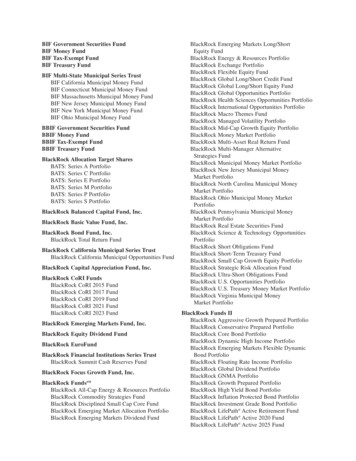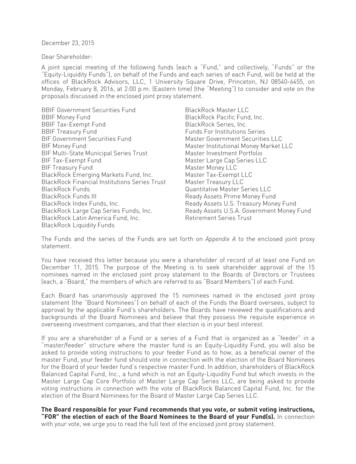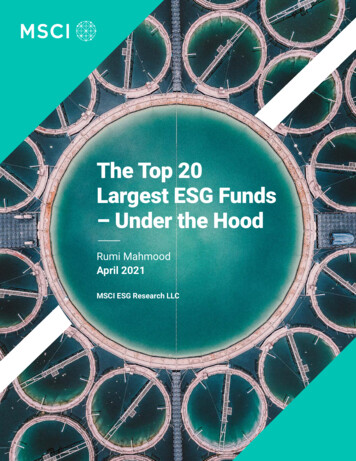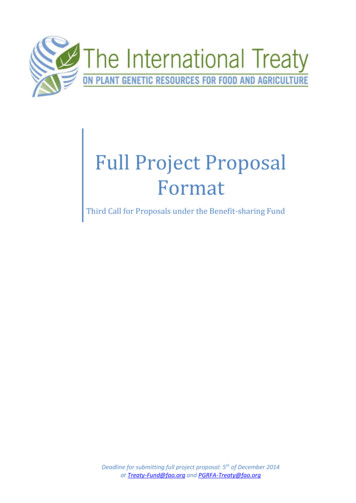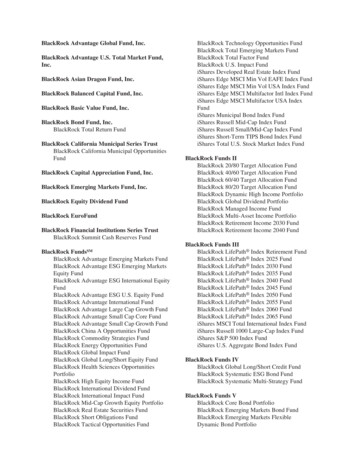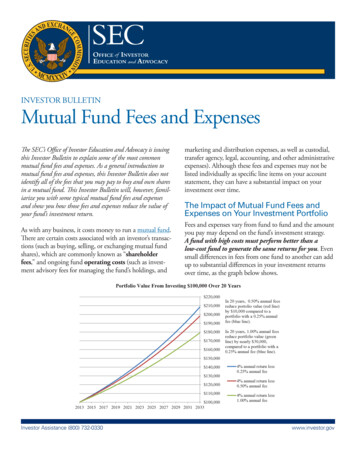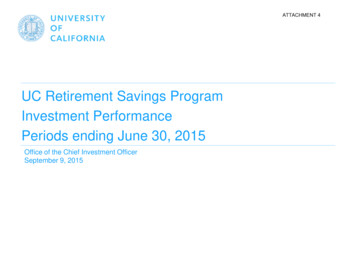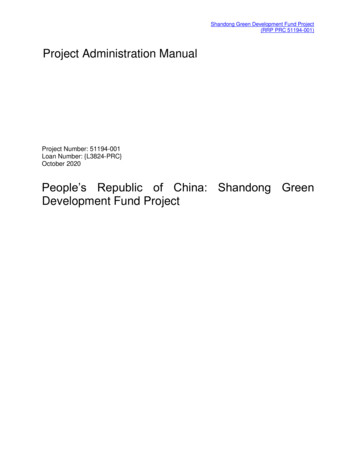
Transcription
Shandong Green Development Fund Project(RRP PRC 51194-001)Project Administration ManualProject Number: 51194-001Loan Number: {L3824-PRC}October 2020People’s Republic of China: Shandong GreenDevelopment Fund Project
Asian Development Bankclimate changecarbon dioxideChinese yuanenvironmental and social management systemframework cooperation agreementfinancial intermediation loanfinancial management assessmentgreenhouse gasesinternational financing institutionmonitoring, evaluation, and verificationMinistry of FinanceNational Development and Reform Commissionproject administration manualprivate, institutional, and commercialPeople’s Republic of Chinarevolving escrow accountShandong Development Investment Holdings GroupShandong Province Finance BureauShandong Green Development Fundsmall- and medium-sized enterprisesstatement of utilization of funds
DEFINITION OF TERMSa “Capacity Development Program” means a program funded under ADB loan to support theproject implementation through consulting services;“Catalytic Fund” means a Fund, established for a term of 20 years or such other term asADB may agree, into which SDIHG channel the proceeds of the Loan, together withproceeds of other financing it receives from IFIs for the project, and into which othergovernmental or multilateral investors acceptable to ADB may invest, as ADB may agreefrom time to time;“CO2 Equivalent Emissions” means the equivalent quantity of greenhouses gases emissionexpressed in carbon dioxide (CO2) equivalent as per the definition of the IntergovernmentalPanel on Climate Change;“Consulting Services” means consulting services as described in the ADB’s ProcurementRegulations and set out in the Procurement Plan included in Annex to this PAM and to befinanced out of the proceeds of the Loan;“Debt Investment” means an investment, or part of an investment, by a Fund in a QualifiedEnterprise that, at the time the investment is made, is permitted to be recorded as a liabilityon the books of the investee in accordance with applicable accounting rules;“Fund” means a limited partnership established on terms acceptable to ADB for a periodacceptable to ADB to invest, either directly or through other funds, into Qualified Enterprisesto undertake Qualified Subprojects and, unless ADB agrees otherwise, managed by theFMC;“GAP” means the gender action plan for the project approved by ADB and implemented bythe Fund Manager;“Green Procurement” means the green procurement standards customized from theEuropean Union for greening a subproject’s supply chain such that it shifts from ‘GoodPractices’ to ‘Advanced Benefits’.“Investment Agreement” means an agreement or set of agreements between a Fund anda Qualified Enterprise, using templates to which ADB has given a written non-objection,for the provision of debt, equity or mezzanine finance to the Qualified Enterprise to be usedexclusively to undertake a Qualified Subproject, and setting out all of the Projectrequirements to be performed or achieved by the Qualified Enterprise in applying theFund’s investment to the Qualified Subproject;“Limited Partnership Agreement” means an agreement among general partners and limitedpartners establishing a Fund as a limited partnership, reflecting the requirements of the LoanAgreement, the Project Agreement and this PAM, and to which ADB has given a writtennon-objection in each case;“MERV” means monitoring and evaluation reporting and verification. A comprehensivedigital platform for enhanced project management information system and MERV wasdeveloped during the project preparation to facilitate the various reporting requirements fromthe IFIs and from the central and provincial governments. The MERV complies with theformat of the Annual Performance Report of the Green Climate Fund used by SGDF forreporting;“PAM” means this project administration manual for the Project;“Procurement Policy” means ADB’s Procurement Policy - Goods, Works, Nonconsulting andConsulting Services (2017, as amended from time to time);“Procurement Regulations” means ADB’s Procurement Regulations for ADB Borrowers Goods, Works, Nonconsulting and Consulting Services (2017, as amended from time totime);
“Qualified Enterprise” means a company that satisfies all requirements in this LoanAgreement, the Project Agreement and the PAM for an investee company to receiveinvestment from a Fund;“Qualified Subproject” means an undertaking that satisfies all requirements in this LoanAgreement, the Project Agreement and the PAM for subprojects to receive investment froma Fund;“Safeguard Policy Statement” or “SPS” means the Safeguard Policy Statement of ADB(2009);“Shandong Green Development Fund Green Climate Assessment Guidelines” means ascreening tool developed during project preparation and customized from the Green ClimateFund Investment Framework to categorize potential subprojects as “Transformational”;“Advanced Benefits” or “Good Practices” following six criteria, as further described in Annex8 hereto];“SOURCE” means digital platform developed by ADB to fast track the delivery ofinfrastructure subprojects. It is designed to help public sector agencies better prepare,manage and publish their infrastructure projects to attract top tier private sector investors.This cloud-based system allows the FMC to present information on all aspects ofdevelopment of an infrastructure project in a transparent, consistent and efficient manner,using sector-specific sets of templates in several languages, including Chinese.aWhere the Loan Agreement or Project Agreement definition is inconsistent with these definitions, thedefinitions in the Loan Agreement and Project Agreement will prevail. Refer to the Loan Agreement andProject Agreement for terms used herein and not defined below.
CONTENTSPROJECT DESCRIPTION1IMPLEMENTATION PLANS3A.Project Readiness Activities3B.Overall Project Implementation Plan5III.PROJECT MANAGEMENT ARRANGEMENTS6A.Project Implementation Organizations: Roles and Responsibilities6B.Shandong Green Development Fund9C.Key Persons Involved in Implementation12D.Project Organization Structure13IV.COSTS AND FINANCING14A.Cost Estimates Preparation and Revisions14B.Key Assumptions15C.Detailed Cost Estimates by Expenditure Category15D.Allocation and Withdrawal of Loan Proceeds15E.Commitment and Disbursement S-Curves17F.Fund Flow Diagram20V.FINANCIAL MANAGEMENT21A.Financial Management Assessment21B.Disbursement Arrangements for ADB Funds23C.Accounting24D.Auditing and Public Disclosure25VI.PROCUREMENT AND CONSULTING SERVICES26A.Advance Contracting26B.Procurement of Goods, Works, and Consulting Services27C.Procurement Plan27D.Consultant's Terms of Reference27VII.SAFEGUARDS27A.Environmental and Social Management System29B.Disclosure29C.Grievance Redress Mechanism29D.Prohibited investment activities30VIII. GENDER AND SOCIAL DIMENSIONS30IX.PERFORMANCE MONITORING, EVALUATION, REPORTING, ANDCOMMUNICATION32A.Project Design and Monitoring PTION POLICY37XI.ACCOUNTABILITY MECHANISM37XII.RECORD OF CHANGES TO THE PROJECT ADMINISTRATION MANUAL38ANNEX 1:SUBPROJECT SELECTION CRITERIA39ANNEX 2:ADB PROHIBITED INVESTMENT ACTIVITIES LIST42ANNEX 3:SAMPLE STATEMENT OF UTILIZATION OF FUNDS43ANNEX 4:PROCUREMENT44ANNEX 5:NATIONAL COMPETITIVE BIDDING82ANNEX 6:TEMPLATE FOR SEMI-ANNUAL PROGRESS REPORT83ANNEX 7:STATUS OF COMPLIANCE WITH MAJOR LOAN AND PROJECT COVENANTS88ANNEX 8:SGDF GREEN CLIMATE ASSESSMENT GUIDELINES89ANNEX 9:GENDER ACTION PLAN118I.II.
Project Administration Manual Purpose and ProcessThe project administration manual (PAM) describes the essential administrative andmanagement requirements to implement the project on time, within budget, and in accordancewith the policies and procedures of the government and Asian Development Bank (ADB). ThePAM should include references to all available templates and instructions either throughlinkages to relevant URLs or directly incorporated in the PAM.The Shandong Provincial Government, as the executing agency, the Shandong Developmentand Investment Holdings Group, as the implementing agency and CICC Capital ManagementCo. Ltd, as the Fund Management Company are wholly responsible for the implementation ofthe ADB-financed Project, as agreed jointly between the borrower and ADB, and in accordancewith the policies and procedures of the government and ADB. ADB staff is responsible forsupporting implementation, including compliance by the Shandong Provincial Government, theShandong Development Investment Holdings Group and CICC Capital Management Co. Ltdof their obligations and responsibilities for Project implementation in accordance with ADB’spolicies and procedures.At Loan Negotiations, the borrower and ADB shall agree to the PAM and ensure consistencywith the Loan and Project Agreements. Such agreement shall be reflected in the minutes of theLoan Negotiations. In the event of any discrepancy or contradiction between the PAM and theLoan and Project Agreements, the provisions of the Loan and Project Agreements shall prevail.Defined terms used in the PAM have the same meanings as in the Loan Agreement and ProjectAgreement unless otherwise defined in the PAM.After ADB’s Board approval of the Project's report and recommendations of the President(RRP), changes in implementation arrangements are subject to agreement and approvalpursuant to relevant government and ADB’s administrative procedures (including the ProjectAdministration Instructions) and upon such approval, they will be subsequently incorporated inthe PAM.
I.PROJECT DESCRIPTION1.Shandong is ranked the 8th province in terms of provincial gross domestic product (GDP)per capita, and the provincial capital, Jinan, ranks 21 out 34 People’s Republic of China (PRC)capitals in GDP. Shandong is facing multiple climate vulnerabilities that include climate impactedwater resources as a lead limiting factor for growth at the core of the water – food – energy nexus.Shandong was selected as pilot for the Shandong Green Development Fund (SGDF), given itstrack record of focused efforts on climate issues and because it is challenged by high greenhousegases (GHG) emissions deriving from its history of rapid industrial development. Shandong isrequired to reduce its carbon dioxide (CO2) emission intensity by 20.5% by 2020, which is thetoughest goal set for a province by the government. Shandong is a province with a largepopulation (99.47 million in 2016) and with high contribution to overall national GDP growth. TheState Council has approved Shandong to become a pilot for action to shift to a low carbon andresilient growth paradigm. Meeting this paradigm shift and climate change targets requires betteraccess to climate finance for climate related projects going beyond business as usual (BAU).2.The project will pilot an innovative leveraging mechanism to catalyze private, institutionaland commercial (PIC) capital for the development of climate positive infrastructure and businessin Shandong Province. 1 The project will support a portfolio of mitigation and adaptationsubprojects assessed against both climate and financial eligibility criteria. The project willcontribute to the province’s transition to low-carbon and climate-resilient development patterns.The Project aims to crowd-in PIC finance for climate positive subprojects assessed against bothclimate (e.g. GHG reduction plus land, water, and air pollution indicators) and financial (e.g.financial internal rate of return, debt service coverage ratio) eligibility criteria. The Project consistsof a mix of public and private sector capital of CNY10 billion ( 1.35 billion), including catalyticresources of around 340 million ( 400 million) from international financing institutions (IFI),required to reach sufficient critical mass of funding to achieve a significant leverage ratio over 5.The Project finances a portion of the total capital expenditures of selected climate positivesubprojects for a capped period to make the subprojects bankable. The SGDF is a multi-tieredfund structure that includes a 20-year Catalytic Fund, holding seed capital from IFIs, which willinvest with PIC investors in a series of shorter-tenor time-separated funds (expected to be namedSGDF I, II, III and IV) to make climate positive investments in qualified subprojects directly andthrough selected municipal and sectoral sub-funds. The level of financing from SGDF and thefinancing terms and conditions are linked to the climate performance of the subproject assessedagainst the SGDF Green Climate Assessment Guidelines 2 developed during the projectpreparation from the Green Climate Fund (GCF) investment framework.3.SGDF targets higher risk climate positive infrastructure subprojects green and hightechnology manufacturing businesses and investment in municipal and sectoral sub-funds inShandong Province, PRC. All SGDF investments must be made into Qualified Enterprises andbe used to finance Qualified Subprojects, as such terms are defined in the Loan Agreement andProject Agreement for the Project. Eligibility criteria for SGDF investments are primarily set out inAnnex to this PAM and include requirements for governance, implementation arrangements,environmental and social management system (ESMS) arrangements and Gender Action Plan(GAP). Invested enterprises and subprojects must also follow monitoring and evaluation reporting12At least 70% of the subprojects (as per fund commitment) financed need to be located in Shandong Province.Shandong Green Development Fund Green Climate Assessment Guidelines (accessible from the list ofSupplementary Documents in Appendix 2 of the Report and Recommendation of the President) developed duringproject preparation: TA9438-PRC Preparing the Green Finance Catalyzing Facility.
2and verification (MERV), as described in Section IX of this PAM. The climate positive subprojects’pipeline spans several sub-sectors and focuses on maximizing investment in mitigation (75%),resulting in a conservative estimate of 37.5 million tons of carbon dioxide equivalent (tCO2eq)over the 20 years lifespan of SGDF and adaptation (25%) with 7.5 million direct beneficiaries.4.Priority Investments: SGDF investment priorities are determined by a climatevulnerability assessment,3 summarized into the Climate Change Assessment,4 which determinestarget SGDF portfolio weightings. For mitigation sectors the priorities are to address the mainsources of GHG emissions (including but not limited to): (i) energy sector with renewable energyincluding wind, solar, biomass, geothermal and emerging technology investments; (ii) green(energy efficient) building and heating/cooling systems; and (iii) low carbon transport withsupporting investments in new energy vehicles and bus rapid transit green corridors. Based onthe provincial modeling of climate vulnerabilities, Shandong’s adaptation priorities are (includingbut not limited to): agricultural and urban water supply infrastructures; city flood resilience orsponge cities through low impact development that includes flood proofing and urban lifelinesystems such as water supply, drainage; city greening, coastal protection and solid waste.5.Impact. The impact of the Project is aligned with the Intended Nationally DeterminedContribution (INDC): 5 (i) peaking of CO2 emissions around 2030 or earlier on best effortsachieved.6.Outcome. The outcome is Climate resilience in Shandong Province enhanced.7.Outputs. The outputs of the Project are (i) SGDF established with PIC financingleveraged, (ii) Knowledge and skills of local governments, civil society, and private sector toprepare climate positive subprojects enhanced. The Design and Monitoring Framework isincluded in Appendix 1 of the Report and Recommendations to the President.8.Output 1: SGDF established with PIC financing leveraged. SGDF established with PICfinancing leveraged. SGDF is structured as an investment pooling vehicle for climate financingand run by a professional fund management company (FMC). SGDF targets to invest 75% inmitigation (measured through CO2eq emission reduction) and 25% in adaptation (measuredthrough improvement of the beneficiaries’ resilience). The project leverages PIC funding at marketrate and at risk at both the SGDF level as well as at the subproject or sub-fund level withrefinancing occurring from year 5 to 15.9.Output 2: Knowledge and skills of local governments, civil society, and privatesector to prepare climate positive subprojects enhanced. The FMC will manage a capacitydevelopment program for project development assistance, policy advisory, capacity building andknowledge management.345Mitigation and Adaptation Priorities in Shandong (accessible from the list of Supplementary Documents in Appendix2 of the Report and Recommendation of the President) developed during project preparation: TA 9438-PRCPreparing the Green Finance Catalyzing Facility.Climate Change Assessment (accessible from the list of linked documents in Appendix 2 of the Report andRecommendation of the President).Government of PRC. 2015. Intended Nationally Determined Contribution. Paris.
3II.A.IMPLEMENTATION PLANSProject Readiness Activities10.The current project has been approved on 25 September 2019 and the loan and projectagreements signed in December 2019. Cofinancing has been approved by the respectivecofinanciers: Collaborative co-financing with Kreditanstalt Fὓr Wiederaufbau (KfW) and AgenceFrançaise de Développement (AFD) and ADB administered loan from the Green Climate Fund(GCF), hereafter GCF loan. Domestic procedures for cofinancing will be completed in 2020.Shandong Provincial Government (SPG), the Project executing agency (EA) represented by theShandong Province Finance Bureau (SFB) and Shandong Development and Investment HoldingGroup (SDIHG), a wholly state-owned enterprise of SPG, the Project implementing agency (IA)have undertaken the following project readiness activities:(i)(ii)(iii)A professional fund manager, CICC Capital Management Ltd (CCM) was selectedin March 2018 by SDIHG to establish and manage SGDF through an FMC.Subproject selection criteria have been discussed and agreed with the EA and theIA (loan and project agreement signed; andEnvironmental and social management system is finalized and adopted by theFMC.11.Table 1 presents the indicative timing of the main project readiness activities that needsto be accomplished in order to achieve loan effectiveness by 2020 Q2 and cofinancing approvedand signed by 2020 Q4. SFB will establish the Foreign Currency Withdrawal account (FWA)denominated in USD and in Euro at the Account Bank to receive foreign currencies from the IFIs.SDIHG will establish the Chinese Yuan (CNY) Conversion Account (CCA) in CNY to receive theconversion of Foreign Currency to CNY from the IFIs before transferring the loan proceeds to theSGDF’s Catalytic Fund as Limited Partner (LP). The FMC will establish and manage SGDFAccount, dominated in CNY, to receive loan proceeds from the LPs (SDIHG, PIC investors andGeneral Partners).
4Table 1: Project Readiness ActivitiesMonths2020Indicative ActivitiesLoan fact-finding(Additional Financing)Term Sheet FundManagement signedFMA and LPA signedESMS approvedLoan effectiveness(current project)FCUP approval(Additional Financing)Loan Negotiations(Additional Financing)ADB approval(Additional Financing)Loan signing(Additional Financing)3456789202110111212Responsible Agency /GovernmentADB, SPGSDIHG, CCMSDIHG, CCMADBADB, SPG, MOFNDRC, SPGADB, MOF, SPGADBADB, MOF, SPGADB Asian Development Bank, CCM CICC Capital Management Ltd, FCUP Foreign Capitalization Utilization Plan,FMA Fund Management Agreement, LPA Limited Partnership Agreement, MOF Ministry of Finance, NDRC National Development and Reform Commission, SPG Shandong Provincial Government, SDIHG ShandongDevelopment and Investment Holding Group.Source: Asian Development Bank.
5B.Overall Project Implementation Plan12.The project implementation period is 7 years from January 2020 to December 2026. The ADB loan and the ADB administeredloan will be drawn out over a period of 7 years and are expected to close on 31 December 2026. The project implementation plan isshown in Table 2.Table 2: Overall Project Implementation PlanTASKS / YEAR1. Shandong Green Development Fund Set-upSet-up SGDF with 340 million catalytic fundsApprove one climate positive subprojectImplementation Period for Disbursement (IFI)Leverage pilot climate positive subprojects by re-investing catalytic loans with PIC2. Project DevelopmentRecruit consultants for the Capacity Development ProgramDevelop and screen SGDF pipeline of bankable climate positive subprojectsPrepare climate positive subprojectsImplement Green Procurement Guidelines in at least 1 subprojectImplement Climate and Financial Ratings of subprojects financed by SGDF3. Knowledge and Capacity DevelopmentTrain FMC, local governments, and qualified enterprisesImplement with SGDF the SOURCE and MERV digital platformaImplement at least 3 policy seminars and document outcomes20202021202220232024202520262027ADB Asian Development Bank, IFI International financing Institution; MERV monitoring and evaluation reporting and verification, PIC private, institutional,and commercial, SGDF Shandong Green Development Fund.a Refer to Definition of Terms in this PAM.Source: Asian Development Bank
6III.A.PROJECT MANAGEMENT ARRANGEMENTSProject Implementation Organizations: Roles and Responsibilities1.General13.SPG is establishing SGDF under an experienced financial intermediary, SDIHG, a StateOwned Enterprise fully owned by SPG supported by CCM. SDIHG operates under the PRC’scommercial law and is financially autonomous. SDIHG has experience in ensuring that plannedinvestments meet broader policy requirements, as well as more stringent criteria than commonpractice. Qingdao municipal government is investing into SGDF as a limited partner (LP) to: (i)strengthen Qingdao as a regional green investment center; and (ii) leverage its contribution withPIC finance to fund climate positive urban subprojects and green businesses in Qingdao. A fundmanager incorporated in the PRC, CCM, wholly owned subsidiary of China International CapitalCorporation Limited was selected by SDIHG to manage the FMC of SGDF based on the followingrequirements: (i) top tier asset manager in the PRC; (ii) licensed by the regulator to operate a fundin the PRC; (iii) over 8 years’ experience, including opening and closing a fund; and (iv)experience with public and donor funding mechanisms.14.SFB receives the loan proceeds from the Ministry of Finance (MOF), maintains the foreigncurrency account and transfers the proceeds to SDIHG in local currency for channeling througha 20-year Catalytic Fund to manage and recycle the long-term catalytic funding from IFIs,including ADB into a series of shorter-term funds that reflect PIC investors’ investment horizonsand market practices. Generally, the funds will have an investment period of 4–5 years, an exitperiod of 3 years and a possible 2-year extension period to complete exits from investments in anorderly manner. CCM and SDIHG, using their own funds will invest into the SGDF funds as CoGeneral Partners. Distributions from the shorter-term funds will be made to the Catalytic Fund;and the Catalytic Fund will reinvest these distributions in new SGDF funds except as distributedto SDIHG to pay its debt service on on-lent IFI debt.
7Figure 1: SGDF Fund StructureADB Asian Development Bank; AFD Agence Française de Développement; CCM CICC Capital ManagementCo., Ltd.; EA executing agency; FMC fund management company; KfW Kreditanstalt Fὓr Wiederaufbau; IA implementing agency; MOF Ministry of Finance; PIC private, institutional and commercial; PRC People’sRepublic of China; SDIHG Shandong Development and Investment Holding Group; SPG Shandong ProvincialGovernment15.The FMC will provide SGDF with the following services among others: finalizing the fundstructure based on market testing and establishing SGDF under proper governance arrangementsubject to ADB no objection.16.The staff of the FMC will be gender-balanced with diverse backgrounds and expertise infinancial, technical, environment and social development. Staffing is expected to be around 30experienced full-time staff with academic qualifications and suitable experience to implement andmanage SGDF. Additional resources can be drawn from the Capacity Development Programunder the ADB loan. The FMC will require expertise to conduct but not limited to the following (i)assessing the risk profile of the subprojects, businesses and sub-funds; (ii) evaluating thetechnology and business model; (iii) assessing capacity of the subprojects sponsors; (iv)reviewing and assessing subproject applications according to the selection criteria and approvalprocess for subprojects; (v) recommending to SGDF investment committee the subprojects,businesses and sub-funds to be financed with the funding modality; (vi) obtaining ADB’s noobjection6 where it is required; (vii) establishing proper risk management mechanism to monitorits green rating, credit risk, interest rate risk and foreign exchange risk etc. in connection with theProject; (viii) monitoring the implementation progress of subprojects, including compliance withthe terms and conditions of the subproject implementing contracts, and ESMS; (ix) takingremedial actions in the event of noncompliance with the obligations; (x) preparing the IFIs loanwithdrawal applications; (xi) participating in the external audit of subproject accounts by providingIFIs access to project auditors; and (xii) monitoring interest payment, return from early stageinvestment, and principal repayment and equity investment by the subproject sponsors; and (xiii)bi-annual reporting to ADB.17.Key staff’s CVs and subsequent replacements in the first 10 years of operation are subjectto ADB’s no objection and include: General Manager; 2 Deputy General Managers; Chief6ADB will consolidate no objection with comments from the other IFIs.
8Financial Officer. At least one key staff should be a woman and one key staff should speakEnglish. As part of the ESMS Arrangement, a full time Safeguard Manager (or FMC SafeguardSpecialist) and a full time Social Development Specialist will be recruited with additionalenvironmental and social development staff recruited or drawn from the Capacity DevelopmentProgram, as required.2.Management Roles and Responsibilities18.The roles and responsibilities of the different entities involved in project implementationand oversight are summarized in Table 3.Table 3: Roles and Executing Agency(SPG representedby SFB)ImplementingAgency (SDIHG)FundManagementCompany (CCM)Management Roles and Responsibilities Enter into on-lending agreement with MOF; Enter into Project Agreement with ADB and ensure compliance with itscovenants and provisions; Responsible for coordinating project implementation activities amonggovernment agencies. Administration of advance accounts for ADB and GCF loans. Ensure that ESMS is established and implemented by the FMC; Open a CCA to invest as LP/ GP into SGDF’s Catalytic Fund for investment andcapacity development program; As LP, enter into an LPA for SGDF I to IV together with public and PIC investors; As Co-GP, enter into an LPA for SGDF I to IV; As GP on behalf of the Fund and as Project Implementing Agency, enter into aFund Management Contract with CCM to act as FMC for all funds in SGDF; Recommend subprojects to be financed to the Investment Committee, and; Prepare and submit reporting and annual audited financial statements to ADB,as described into the auditing and reporting sections of the PAM. Act as FMC of all funds in SGDF and assume responsibility for day-to-dayProject implementation; Provide staff resources with competence in technical, safeguard, and financialissues pertaining to the Project implementation; Open and maintain SGDF local currency account to receive and manage capitalcontributions from LPs/GPs; Review and assess subproject applications according to the selection criteriaand approval process for Subprojects described in the Loan Agreement andProject Agreement and this PAM; Manage SGDF Investment Committee; Sign Investment Agreements with Qualified Enterprises for Qualified Subprojectfinancing; Assume overall responsibility to prepare and approve subprojects based on theapproved ESMS; Adopt and cause each SGDF fund to adopt and implement the ESMS (and thesubsequent amendments to the ESMS) for all the investments funded by SGDF. Establish a Grievance Redress Mechanism (GRM) at the SGDF level; Monitor the implementation progress of the SGDF group of funds, includingcompliance with the terms and conditions of the investment agreements. Require remedial actions or exercise contractual and legal remedies in theevent of noncompliance with the obligations; Prepare ADB and GCF loan withdrawal applications with the necessary
rises(investees of SGDFfunds)ADBManagement Roles and Responsibilitiessupporting documents described in the disbursement section of this PAM; Participate in the external audit of Project accounts by providing ADB access toProject auditors; Monitor payments from Qualified Enterprises; Prepare and submit reports as per the reporting section of the ProjectAgreement and this PAM; and Obtain ADB’s no objection where required. If an investee of a debt investment, repay loan principal and interest in a timelymanner as stated in the relevant agreements; Implement the subproject in accordance with the Investment Agreement; Comply with applicable requirements of the ESMS, including providinginformation and reports requ
VI. PROCUREMENT AND CONSULTING SERVICES 26 A. Advance Contracting 26 B. Procurement of Goods, Works, and Consulting Services 27 C. Procurement Plan 27 D. Consultant's Terms of Reference 27 VII. SAFEGUARDS 27 A. Environmental and Social Management Sys




